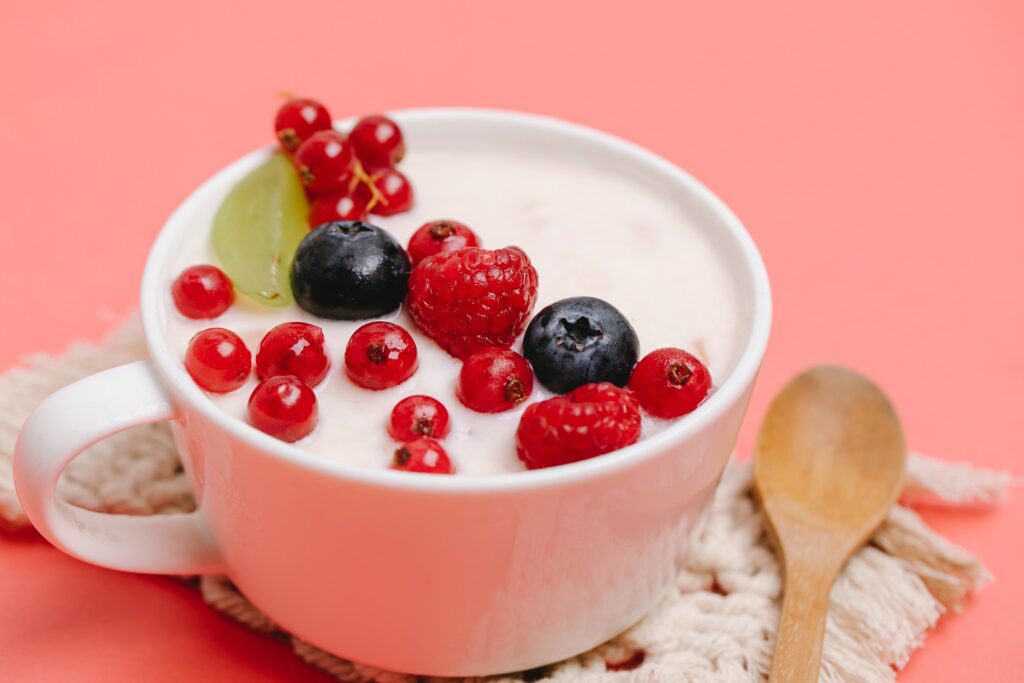I regularly use Greek yogurt when preparing meals, especially at breakfast, where I love drizzling it with raw honey, covering it with homemade berry compote, or simply as a dollop on overnight oats. It’s also an essential component of my 3-ingredient flatbread, which gets a lot of visits on my Instagram TV channel. However, many people have asked me if they could swap regular yogurt for it. My answer? They are both made from the same ingredients (although traditionally, Greek yogurt is made from sheep’s milk, today we mostly find Greek-style yogurt made from cow’s milk), are full of probiotics and are generally considered to be “healthy”. The difference in their fabrication method is that Greek yogurt is strained and the regular one is not. Why does it matter? Continue reading.
Greek is great when thick and creamy is required
When I was living in Dubai, it was very common to see labneh – a very thick, slightly salty, strained yogurt very similar to Greek-style yogurt – in Middle Eastern cuisine. It was often served for breakfast with bread, as an appetizer dip (often mixed with herbs and spices such as za’atar), or as a base for roast tomatoes, aubergines, and other delicious vegetables. Because it is spreadable, it works really well for these types of dishes, which I now regularly serve at our dining table. You can also mix it with flour and a bit of salt to make these delicious flatbreads.
More protein
Greek yogurt is denser than the unstrained kind and therefore has a higher protein content – between 2 and 3 times more. Because I don’t eat much meat, I quite like having other sources of protein when I can, so this is perfect, especially in the morning because protein is filling and keeps me going for longer.
Greek has less lactose, sugar, and carbs
The straining process takes out part of the whey and lactose found in regular yogurt. This means that people who have a sensitivity to lactose generally find it easier to digest (in reasonable amounts of course). Also, less lactose means less sugar/carbs, so if you are looking for a lower sugar/carb yogurt option that is minimally processed, Greek yogurt is usually best. In fact, it has almost half the sugar and half the carbs of regular yogurt. It is more tart but somehow, the creamy texture makes up for it.
Unstrained is best for these recipes
Now, don’t think I never use unstrained yogurt. Au contraire, I use it a lot. In fact, its tanginess and more liquid texture are absolutely necessary when making “raita”, certain Indian curries, meat/poultry marinades, or other recipes like this Persian cucumber dip. It is also lighter – and I don’t just mean it is lighter in fat (which it is) – so you can easily drizzle it and pour it on top of preparations without feeling like you are adding a big dollop of cream, make sense?
Unstrained has more calcium
If you are going for calcium, then definitely go for unstrained because it has roughly double the amount.
Either way, France loves yogurt
I live in yogurt heaven. Here in dairy-loving France, most people have grown up eating the regular kind as an everyday kind of dessert (plain yogurt with sugar is still a staple in school cafeterias), and continue to do so into adulthood. You find dozens and dozens of flavors of unstrained yogurt at the supermarket: plain, lemon, chocolate, vanilla, berry, peach, mango, apricot, cherry, firm, not firm, with sugar or without, and the list goes on. They have also grown up with Greek yogurt (which was is served as a common dessert with sugar, honey, or compote) but funnily enough, they call it “petit suisse” and it is sold in tiny containers the size of an espresso cup. Big tubs of Greek-style yogurts only became easy to find in supermarkets in more recent years, as the French have become quite fond of international cuisines and foods – which is great for this Canadian, Euro-Middle Eastern, Mediterranean-loving gal.
As always, if you’ve got any more specific questions about this, just reach out and I’ll be happy to help.




